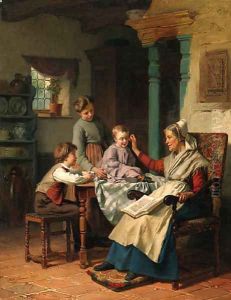Thodore Grard Paintings
Théodore Gérard was a Belgian artist known for his genre scenes and historical paintings. Born on April 11, 1829, in Ghent, Belgium, he developed an interest in art at a young age and pursued his passion with great dedication. Gérard studied at the Ghent Academy under the guidance of renowned painter Théodore-Joseph Canneel. His early work was influenced by Flemish and Dutch genre painters, and he honed his skills in creating detailed narratives within his paintings, often with a focus on the lives of the middle and lower classes.
Gérard's talent for capturing the nuances of everyday life, as well as his ability to imbue his historical subjects with a sense of realism and humanity, quickly gained him recognition. He participated in various exhibitions, notably in Belgium and France, and his works were met with critical acclaim. In 1855, he moved to Brussels, which was then a vibrant artistic hub, allowing him to immerse himself in the city's cultural life and further his artistic career.
Throughout his lifetime, Théodore Gérard received numerous accolades and was a respected member of several art societies. His paintings often depicted scenes of family life, children at play, and women engaged in domestic tasks, showcasing his keen observation and sensitivity towards his subjects. Gérard's use of color and light was also noteworthy, as he mastered the art of creating atmospheric effects that enhanced the storytelling aspect of his work.
Gérard continued to exhibit his work widely and with great success throughout Europe. His historical paintings, which were based on careful research and attention to period detail, contributed to the 19th-century romanticism movement, although he maintained a unique style that distinguished him from his contemporaries.
Théodore Gérard passed away on January 28, 1902, in Brussels. Despite the changes in artistic tastes and styles that occurred over the course of his career, Gérard remained true to his artistic vision. His works can still be found in museums and private collections, and they continue to be appreciated for their charm, historical value, and technical skill.
